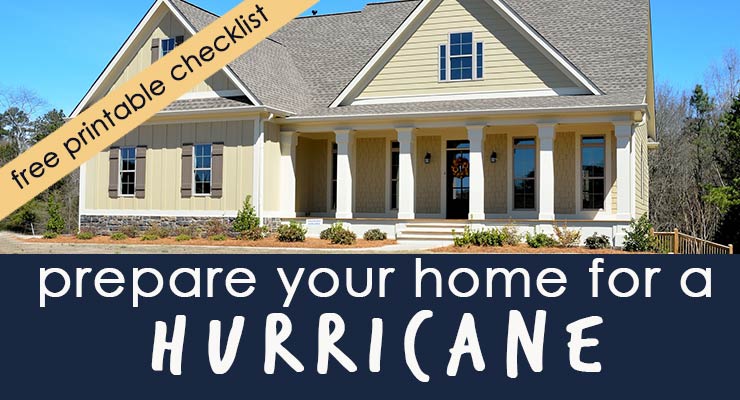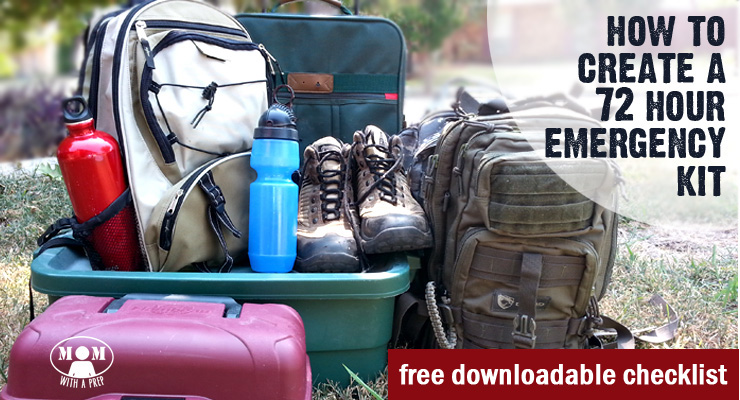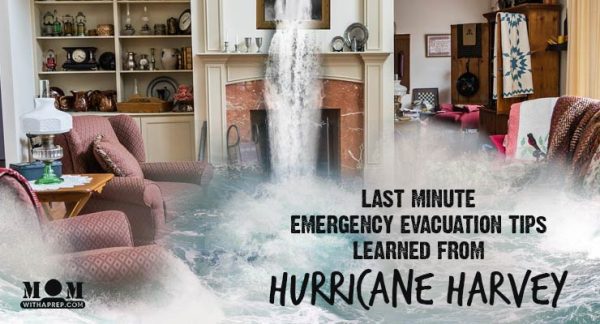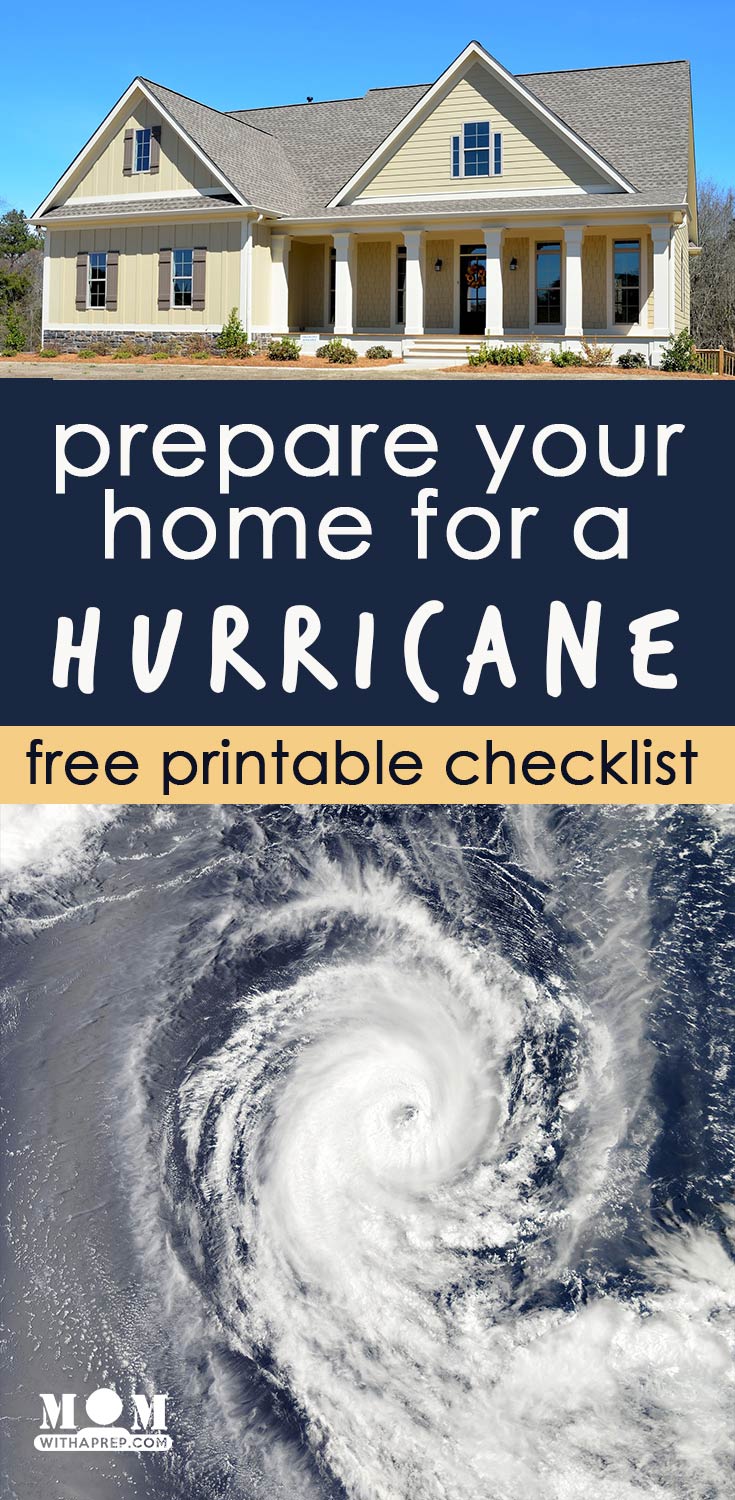Don’t wait for a weatherman to tell you it’s time to prepare for a hurricane. Take matters into your own hands and get your family and home prepared!

50 Things to Do to Prepare for a Hurricane
For the Family
- Check emergency bag or pack one if you don’t have one. (Get a free printable checklist here)
- Create an evacuation plan. Know where you are going, alternative routes to get there, and where you will sleep.
- Keep informed – watching weather channels or local news, and keep a weather app on your phone to be up-to-date.
- Gather important documents into a waterproof container and stick with bag. Consider emailing scanned them to yourself (or a trusted friend) and uploading into a secured cloud. I would also suggest to do this with your precious family photos if you have time. If you haven’t had time to do so, consider using the Lifesite Vault app to scan quickly and store.
- Create a phone wheel with someone outside of your disaster zone as your contact person that everyone can check in with and get direction from.
- Charge all electronics and power bricks.
- Put a light source in every room, whether flashlights, battery-operated lanterns or headlamps. Use candles and oil lamps with caution.
- Get some cash, preferably small bills.
- Stock up on foods you can eat without heat such as canned soups, protein bars, granola, cereals, etc.
- Stock up on water if you don’t have enough stored.
- Write name and identifying info (whether you choose SSN or phone number or address) on the belly or back of you and your family (if you get lost, the kids are identified – if you’re found in need of medical attention, you’re identified)
- Refill prescription meds early (talk to doctor about extending if need be) (Take a screen shot of your meds, just in case)
- Make arrangements for routine health services (dialysis, chemo/radiation)
- Make sure to have current photos of children and yourself on your phone and copies in your emergency binder (the one in your binder may be older)
- Call to make hotel reservations outside the emergency zone.
- Gather life vests
- Gather games and other fun things to pass the time if you are at home for an extended period.
For the Kitchen
- Begin eating perishable foods first so that you don’t lose them in an extended power outage.
- Fill freezer with extra water bottles to keep it frozen if power runs out. You can use whatever kind of bottle or even zip top bags double bagged (though these are not as trustworthy as bottles – they’ll do in a pinch.
- Begin to move food and necessities to higher floors.
- Make sure to have at least a full week of food and water on hand. Water basic is 2 gallons per person for drinking and sanitation, plus 1 gallon per day for pets.
- Fill every container you can with water. You should have a supply of water already stored normally, but fill every available container in case you lose water supply in flooding situation. It is already treated if you are most municipal systems. Alternatively, buy water containers from the store, instead of actual water. Then go home and fill them. You’ll have supplies for the next emergency, too.
- Follow these steps to help prepare your freezer. It’s good to have whatever coolers you own ready in case you need to begin to transfer food. P.S. Those coolers can also be used as flotation devices or to put your emergency items in if you need to make a water escape.
- Make sure any water filters you have are primed and ready for use.
- Bake things now to eat when there is no power – muffins, breads, etc.
For the Home
- Board or shutter and tape windows. It is a good idea to have pre-cut boards stored beforehand. If you can’t get it, tape your windows in a star pattern, and tape up plastic sheeting (use a shower curtain and any tarps, etc. to cover the inside to protect from flying glass or water).
- Check insurance coverage – increase it if you need to – even renters should do this.
- Do a quick home inventory by video if you don’t already have a home inventory sheet done. This is for damage claims later.
- Check maintenance on generator or purchase one.
- Get all laundry and dishes done now.
- Collect work gloves and keep high and dry.
- Secure outdoor furniture and things – including yard art clotheslines, sheds, bbq’s, trashcans, toys, etc.
- Gather evacuation items for signaling in case you need rescue– air horn or whistle (even pots and pans), white sheet, spray paint.
- Fill bathtub plus all other buckets, jugs, jars and containers for non-potable usage. You can use a shower curtain to line it with to help stop leakage if you don’t have a WaterBob or equivalent
- Fill washing machine with water for non-potable usage or fill it with ice to keep oft used items cold and not open the fridge. Plus you’ll have water as it melts.
- Put an axe in the attic (along with work gloves and a lantern) to get through to the roof.
- Bring out fans (battery-operated fans are great if there is a power outage). These may also be useful in drying out after.
- Sandbag around your home if you may flood. If you don’t have sandbags, use bags of dirt from a gardening center.
- Trim trees that may damage your home.
- Check gutters and drains, and anything else attached to your house or garage that may need to be tightened so as not to cause damage.
- Turn off utilities if possible, but remember, do not gas back on without the gas company.
- Keep a light’s out kit handy for power outages.
- Tune all radios to weather alert stations.
- Stock up on cleaning items such as bleach, bleach wipes, outdoor garbage bags, shovels, brooms, mops, paper towels, etc.
- Gather tools such as saw, ax, hammer, nails, screws, shovels, and store in a high location for post-flood recovery.
- Stock up on tarps and duct tape for shelter repair.
- Get a new propane tank.
- Secure any and all firearms securely (they should be already, but make sure you don’t have any tucked away for emergencies that may be damaged or float away.
- Pull out alternative means of cooking. You can use a rocket stove outside (gather sticks and wood now to keep dry), or a propane camping stove (be careful), other cooking device.
- If you are NOT at risk of full flooding…but damage from the hurricane and some water damage (levels lower than 1-2′) you can put valuables in water tight bags into your dishwasher to help keep them safe. However, this is not foolproof and should not be used to store things if your home will be submerged more than 2′.
- Be sure to record the FEMA Tele-registration hot-line: 1-800-462-9029 and Red Cross Hotlines in your emergency binder.
- Create an evacuation kit in case you have to leave and swim it out. (includes a floating kids’ pool, extra soft rope, clothes, kits, safety vests so that you can be seen, etc.)
• READ MORE: Last Minute Evacuation Tips Learned from Hurricane Harvey
For Your Car
- Fill up.
- Check emergency car kit and restock or create one if necessary.
- Do quick maintenance check.
- Put in local maps, extra clothes, and some food in trunk
- Move car to an enclosed storage facility if you can to protect it from flying debris, as long as the facility will not flood.
- Check on insurance coverage for your car for flooding/disasters.
For your Pets
- Make sure pet ID’s tags are on.
- Make arrangements to house them if you can’t take them with you.
- Get carriers out for travel
- Get food put together for emergency bag + watering bowl
- Take photo of pet to put with your emergency bag (and perhaps a photo of you in the carrier for later identification if separated)
- Strap or tie down coops, shelters, fencing.
There are many more ideas, which I hope you’ll put down in the comments. Let’s make sure we have a comprehensive list for those who need to get their homes prepared for the oncoming storms.
Please be safe. Please be smart.
DOWNLOAD YOUR PRINTABLE CHECKLIST HERE
Add it to the Emergency Preparedness section of your Family Emergency Binder (or a hurricane subsection if you have one). Don’t have a binder started?
Katy Willis is a writer, lifelong homesteader, and master herbalist, master gardener, and canine nutritionist. Katy is a preparedness expert and modern homesteader practicing everyday preparedness, sustainability, and a holistic lifestyle.
She knows how important it is to be prepared for whatever life throws at you, because you just never know what's coming. And preparedness helps you give your family the best chance to thrive in any situation.
Katy is passionate about living naturally, growing food, keeping livestock, foraging, and making and using herbal remedies. Katy is an experienced herbalist and a member of the CMA (Complementary Medical Association).
Her preparedness skills go beyond just being "ready", she's ready to survive the initial disaster, and thrive afterward, too. She grows 100% organic food on roughly 15 acres and raises goats, chickens, and ducks. She also lovingly tends her orchard, where she grows many different fruit trees. And, because she likes to know exactly what she's feeding her family, she's a seasoned from-scratch cook and gluten-free baker.
Katy teaches foraging and environmental education classes, too, including self-sufficient living, modern homesteading, seed saving, and organic vegetable gardening.
Katy helps others learn forgotten skills, including basic survival skills and self-reliance.
She's been published on sites such as MSN, Angi, Home Advisor, Family Handyman, Wealth of Geeks, Readers Digest, and more.



